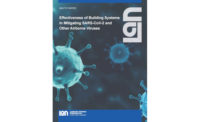More than one year into the COVID-19 pandemic, IMEG engineers have found no evidence of the SARS-CoV-2 virus passing through a building’s HVAC system and infecting people in other spaces. A recent statement from ASHRAE concurs with this assessment.
“It is impossible to say for sure, but to date, we have found no evidence or study showing new cases being attributed to the air handling equipment, or evidence of long-range transmission through an AHU system,” said William Bahnfleth, chairman, ASHRAE Epidemic Task Force.
While there is sufficient evidence to believe that airborne transmission is possible in some circumstances, such as when there is low ventilation in a space, the Task Force adds there is a very low probability for the HVAC system being the route.
“For re-entrainment of the virus to be an issue, there must be someone present in the building shedding the virus, have it captured by the HVAC system, and re-introduced elsewhere,” states the Task Force.
Nevertheless, ASHRAE emphasizes that “it is not possible to reduce risk to zero indoors” and that building HVAC systems warrant being checked.
To provide guidance, the Task Force has issued an updated Building Readiness Guide to help owners prepare their buildings for reopening as cities and states reemerge from COVID-19 shutdowns and restrictions.
The guide suggests owners assemble a team of building staff and design professionals to review the HVAC system. Specific items to address include:
Building controls sensors — Ensure they are functioning properly and providing accurate readings;
Ventilation air — A minimum of code-level outside air should be provided;
Ventilation rates — Can they be increased without impact to major equipment?;
Flushing of spaces — If it’s necessary to provide pre- or post-occupancy flushing of spaces with outside air, identify how long you need to flush the spaces before and after occupancy;
Air filtration — Improved filtration can help, but it depends on the space capture velocity, filter location, and system design. Improved MERV ratings may or may not make a difference.
Ultraviolet germicidal irradiation — UVGI (using ultraviolet C, or UV-C light, to kill or inactivate the virus) can help, but like filters, it depends on placement.
Control sequences and set points — Determine if any changes should be made.
Additional review and startup considerations are included in the guide, with many actions depending on whether an owner was able to continue equipment and system maintenance programs during the shutdown. For example, if the plumbing system has not been operated for days or months, there most likely will be issues to resolve.
It is crucial for all adjustments to a building’s infrastructure to be based on an understanding of the space, the system design, intent, and operation. Changing system settings and sequences of operation without a good understanding of the effects on overall building operations could result in unintended consequences. In addition, owners should be cautious about investing in filters or UV lights inside the AHU, where lengthy duct runs limit their effectiveness. Instead, they should make sure their consultant understands their concerns and can guide them to real solutions.
With an experienced and knowledgeable team following ASHRAE’s guidelines, owners should feel confident they are taking the right steps to help ensure occupant well-being and operational integrity as their building returns to occupancy. For more information, visit www.imegcorp.com.
This article originally appeared on IMEG Corp.’s website. See the original article in its entirety at https://www.imegcorp.com/resources/blog/no-evidence-sars-cov-2-transmitted-via-hvac-but-reopening-buildings-merits-system-review/.





